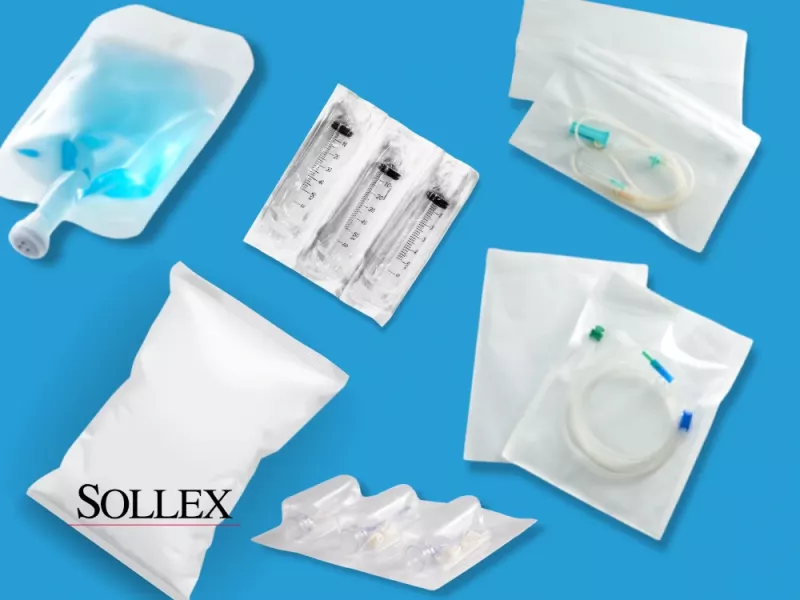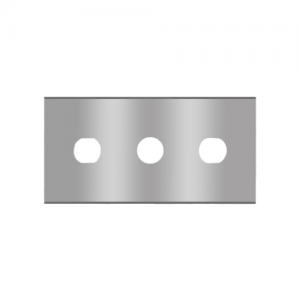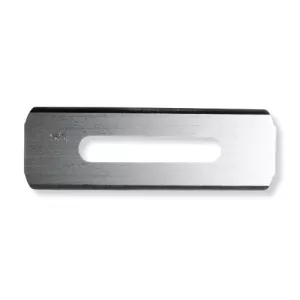Flexible Medical Packaging: Converting and Slitting
Flexible medical packaging is a critical component of the healthcare industry, designed to ensure the sterility, integrity, storage and transport of medical products and devices. The materials used to manufacture this packaging, such as plastic films, paper, tissue and nonwovens, are being developed to meet more demanding regulatory requirements and performance characteristics than other types of films and flexible materials.
Content:
- Materials for medical packaging
- Medical and hygiene films
- Paper-based materials and high-density polyethylene synthetic paper TYVEK® DuPont
- Converting and finishing of medical packaging materials
- Slitting and cutting
- Die-cutting
- Punching
- Perforating
- Laminating and coating
- Heat-sealing
- Printing
- Cutting methods and knives used in the medical packaging industry
- Problems and solutions when cutting medical plastic film
- Optimize medical packaging production with Sollex machine knives and razor blades
Materials for Medical Packaging
Flexible materials, such as plastic films and paper-based goods, are widely utilized in the medical packaging business due to their adaptability, protective properties, and capacity to maintain sterilization. These materials are used to package a wide range of medical and pharmaceutical items.
The list of flexible materials used in medical packaging is long and includes materials like health care and hygiene plastic films, medical grade paper, DupontTM Tyvek® medical paper, aluminized film, foil, flexible polymer film, flow pack wrapper (HFFS), laminated film, and many more. These materials are used to make a variety of medical packaging types, including blister packaging, barrier packaging, flexible packaging, high-barrier plastic packaging, moisture-barrier packaging, laminates, pouches and bags, rollstock, sachets, sterilizable packaging and components, stoppers, tamper-evident packaging, webs, wraps, and shrink wraps.
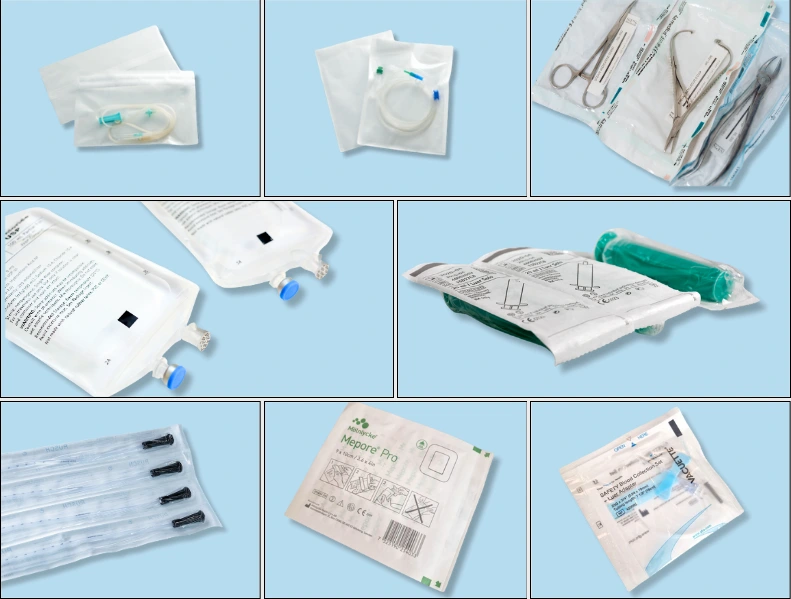
Product Type | Examples of Packaged Products | Packaging Material |
|---|---|---|
Medical Devices | Surgical instruments, catheters, syringes, gloves, wound care products | Tyvek® pouches, plastic film pouches, paper pouches |
Pharmaceuticals | Blister packs, liquid medications, IV bags, transdermal patches | PVC/PET films, aluminum foil, multi-layered films |
Diagnostic Products | Test kits, blood collection devices | Plastic film pouches, medical-grade paper, blister packs |
Implants and Prosthetics | Orthopedic implants, cardiac stents | Tyvek® pouches, plastic film blister packs |
Personal Protective Equipment (PPE) | Face masks, protective clothing | Plastic film pouches, sterilizable paper |
Lab Consumables | Petri dishes, pipette tips | Clear plastic film pouches, resealable plastic containers |
Biological Samples | Specimen bags, cryopreservation bags | Sterile plastic film pouches, specialized plastic films |
Sterilization Packaging | Sterilization wraps | Medical-grade paper, Tyvek® wraps |
Kits and Trays | Surgical kits, first aid kits | Sterilizable pouches, plastic and paper-based materials |
Medical packaging equipment plays a crucial role in ensuring the safety and integrity of healthcare products. These systems include aseptic packaging machines and controlled-atmosphere packaging (CAP) systems, essential for maintaining sterility. Automatic systems streamline the process, while specialized equipment like blister packaging machines, boxing machines, and cartoning machines ensure precise containment. Bagging machines, form-fill-seal (FFS) machines, and four-sided seal packaging machines handle a variety of materials, while filling machines, sachet filling and sealing machines, and open-fill-and-seal machines guarantee accurate dosage. Shrink wrap machines, skin packaging machines, and wrappers offer protection and tamper evidence. Cutting machines, including roller cutting machines, along with inserting machines and collating machines, complete the packaging process, ensuring medical products are securely and efficiently prepared for distribution.
Medical & Hygiene Films
Due to their special qualities, polymer films are most frequently used in flexible medical packaging. For example, polyethylene materials (PE films and laminates) are widely used to make hygienic films such as breathable film, medical laminated film, cast breathable film, embossed film, etc. because of their flexibility, softness, and resistance to moisture. High-density polyethylene (HDPE) is used for applications requiring more strength, whereas low-density polyethylene (LDPE) is best suited for heat-sealed packaging. Another significant material is polypropylene (PP), which is well-known for its superior chemical resistance and appropriateness for sterile packing, such as that used for sterilisable medical items.
Because of its excellent rip strength and resilience to chemicals, polyester (PET) is frequently laminated with other films to create packaging solutions that are more robust and protective. Polyamide, or nylon, is also prized for its strength and resistance to punctures, which makes it very helpful for sterilized packaging where longevity is crucial. Medical packaging also makes use of ethylene vinyl acetate (EVA) because of its strength, flexibility, and transparency. It may also be used to create heat-sealable films.
Due to its optical clarity and impact resilience, polycarbonate (PC) film— like LEXAN —is utilized in medical device components and equipment. For touch interfaces and medical equipment, Autotex® PET film and Autotex® AM hardcoated PET antimicrobial film offer dependable and sanitary surfaces. Primex Plastics and Rochling Industrial's HDPE (High-Density Polyethylene) film, marketed under the PE2PRINT® trademark, provides flexible printing and packaging options. In medical packaging applications, MAPAL polypropylene (PP) film is prized for its heat sealability and resilience to chemicals. With qualities including barrier protection, clarity, and printability, DuPont Melinex® AF2 polyester film, as well as Mylar® PET and Melinex® PET films, meet a variety of medical packaging and labeling demands.
Paper-Based Materials and High-Density Polyethylene Synthetic Paper TYVEK® DuPont™
In parallel, paper-based materials, including medical-grade paper, play a significant role, especially in sterilizable packaging like pouches and wraps. These papers are engineered to permit the penetration of sterilizing agents, such as steam or ethylene oxide, while maintaining a reliable sterile barrier.
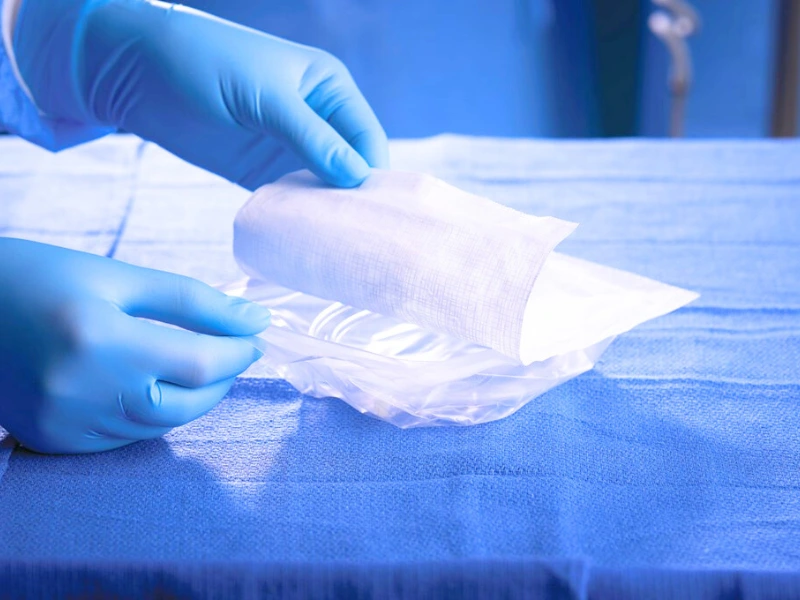
An important material in this category, Tyvek®, manufactured by DuPont. Tyvek® is a unique non-woven synthetic high density polyethylene paper under the DuPont™ TYVEK® brand name, made from continuous strands of HDPE and has an incredibly wide range of applications in medical packaging. TYVEK® is renowned for its robustness, tear resistance, and excellent microbial barrier properties. It is compatible with multiple sterilization methods, including ethylene oxide, gamma radiation, and steam, making it a preferred choice for sterile medical and pharmaceutical packaging. DuPont™ Tyvek® resembles paper, fabric and film all at once.
The table below summarizes aspects of the production, equipment and supply chain of materials used in medical packaging.
Material Type | Manufacturing Process | Machinery | Finished Product |
|---|---|---|---|
Polyethylene (PE) and Polypropylene (PP) Films | Extrusion (Blown/Cast) | Extruders, Chill Rollers, Winders | Supplied as rolls of film to converters and manufacturers. |
Polyvinyl Chloride (PVC) Films | Calendering, Thermoforming | Calendering Machines, Thermoforming Machines | Supplied as rolls or thermoformed packaging (e.g., blister packs). |
Polyester (PET) Films | Extrusion, Biaxial Stretching, Lamination | Biaxial Stretching Machines, Laminators | Supplied as laminated films for barrier protection in packaging. |
Paper-Based Packaging | Pulping, Paper Making, Coating/Laminating | Paper Machines, Coating Machines | Supplied as sheets or rolls for sterilizable packaging applications. |
Tyvek® (High-Density Polyethylene) | Flash Spinning, Bonding | Flash Spinning Machines, Bonding Machines | Supplied as non-woven material for sterile pouches and wraps. |
Converting and Finishing of Medical Packaging Materials
Once the base materials (such as films, paper, and non-woven fabrics) are produced, they undergo various converting and finishing processes to transform them into functional medical packaging.
Slitting and Cutting
In the manufacturing of medical plastic films, tissue, non-woven, paper and others used for medical packaging, the cutting process is a critical operation that significantly influences the quality and performance of the final product. The precision, efficiency, and cleanliness of the cutting process are paramount, given the stringent requirements for sterility and product integrity in medical applications. Slitting machines cut large rolls of film or paper into narrower widths, making them suitable for specific packaging formats like pouches or wraps.
Die-Cutting
Die-cutting is a precise cutting process used to create specific shapes or sizes from films, paper, or other materials. A shaped blade (die) is used to cut the material into the desired configuration, such as custom pouches, trays, or lids.
Punching
Punching involves using a mechanical or hydraulic press to cut out shapes or holes in the packaging material. This process is commonly used to create holes for hanging packages on displays or to punch out areas for product visibility. Punching can also be used to remove excess material, creating a cleaner and more functional final product.
Perforating
Perforating is the process of creating a series of small cuts or holes in the material, allowing for easy tearing or improved breathability. This is particularly useful in medical packaging where controlled ventilation is necessary, or where packages need to be easily opened by the end user without compromising the sterility of the contents.
Laminating and Coating
Laminating involves bonding multiple layers of materials together to enhance the packaging's protective properties, such as moisture resistance, barrier protection, or mechanical strength. Coating processes apply a thin layer of protective or functional material onto the packaging surface, which can improve sealability, add antimicrobial properties, or enhance the material's appearance.
Heat-Sealing
Heat-sealing is a process where heat and pressure are applied to the packaging materials to create a strong, airtight seal. This method is commonly used to close pouches, bags, and other flexible packaging formats, ensuring that the contents remain sterile and protected until use. Pouches are widely used for sterile medical instruments, pharmaceutical products, and other healthcare items.
Printing
High-quality printing machines are used to apply necessary text, graphics, or labels to the packaging material. This may include branding, product information, and sterilization indicators, which are critical for identifying the contents and ensuring that the packaging meets regulatory standards.
Cutting Methods and Knives Used in the Medical Packaging Industry
Plastic films, laminates, paper-based materials, depending on their thickness and material properties, are subjected to various cutting techniques. Slitting is one of the most prevalent methods employed in this industry, where large rolls of film are subdivided into narrower widths. This is achieved through different slitting techniques, including razor slitting, shear slitting, and score / crush cutting. Each technique requires a specific type of blade, and the choice is guided by the nature of the material being processed.
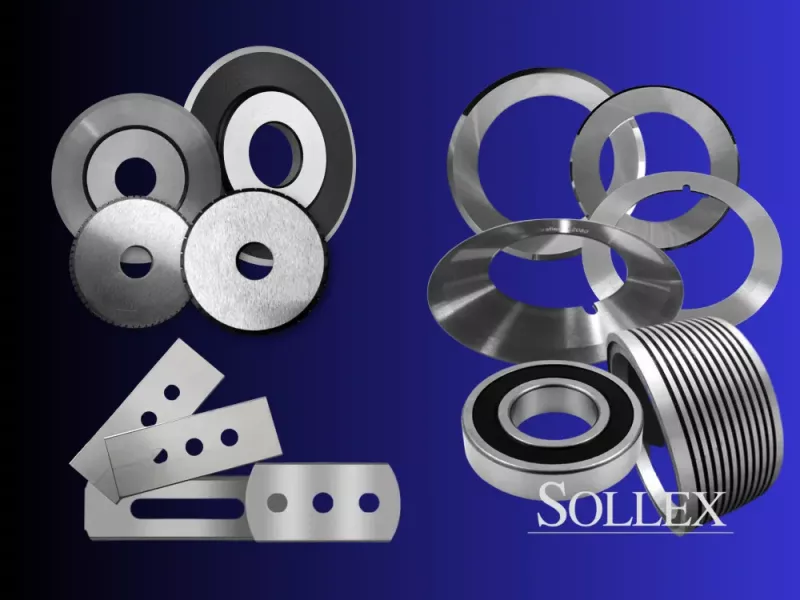
Blade Type | Application | Characteristics |
|---|---|---|
Razor Blades | Razor slitting of thin plastic films | Provides clean cuts with minimal resistance; best for thin films; requires frequent replacement due to wear. |
Shear Blades | Shear slitting of thicker or tougher plastic films | Operates like scissors, offering precise and clean cuts; suitable for thicker materials; longer-lasting but requires proper alignment. |
Crush Cut Blades | Score slitting of resistant materials | Presses material against a hardened roll to crush and cut; effective for tough materials but may produce rougher edges. |
Perforating Blades | Creating perforations for easy tearing or breathability | Features a toothed edge for consistent perforations; critical for uniformity and avoiding material weakening. |
Circular Knives | Slitting and rewinding operations | Versatile for both shear and score slitting; can be used for a variety of film thicknesses; requires precision in setup. |
Custom Dies | Die-cutting for specific shapes (e.g., pouches, lids) | Shaped according to design requirements; crucial for maintaining precision and ensuring the integrity of the final product. |
For instance, razor slitting using industrial razor slitter blades (e.g., slotted slitter blade 5K) is preferred for thinner films, providing a clean cut with minimal resistance, whereas shear slitting, which mimics the action of scissors, is more suitable for thicker and tougher films. In contrast, score slitting, which involves pressing a blade against the material to crush and cut it, is often used for materials that are resistant to other forms of slitting but may result in less precise edges.
Tyvek® type 10 hard structure materials require sharp, clean cutting tools, and slightly rounded blades are preferred for crush cutting due to their durability. Multiple rolls of lightweight Tyvek® can be efficiently sheeted simultaneously, especially when using styles treated to reduce static. For Tyvek® Type 14, which is softer, cutting is similar to fabric, but overheating of the blade must be avoided to prevent melting and edge fusion. Using wavy or serrated blades, applying a lubricant, and reducing the cutting speed and stroke can help minimize these issues.
Perforating and die-cutting are additional processes integral to the production of medical packaging. Perforating involves creating a series of small, consistent cuts within the material, which is essential for products requiring easy tearing or enhanced breathability. This process demands specialized perforating blades, which must be precisely engineered to ensure uniformity and prevent material weakening. Die-cutting, on the other hand, is used to shape films into specific configurations, such as pouches or customized lids, often required for sterile medical packaging. The precision of die-cutting blades is critical, as any deviation can compromise the integrity and functionality of the packaging.
The material and coating of blades are crucial factors that influence their performance and durability. Blades need to be made from high-quality materials, such as tool steel or tungsten carbide, to ensure durability and sharpness. Coatings like ceramic or titanium nitride can increase blade life and reduce friction, enhance wear resistance, and prolong the life of the blade.
Maintenance of cutting equipment is another key aspect that cannot be overlooked. Regular inspection and sharpening of blades are necessary to maintain consistent cutting quality and avoid defects such as jagged edges or material tearing. Dull blades not only compromise the quality of the cut but also increase the risk of contaminating the material, which is a critical concern in the production of sterile medical packaging.
Problems and Solutions When Cutting Medical Plastic Film
The main 3 problems faced by manufacturers and converters of plastic film for medical applications are: film curling and wrinkling, dust and debris and blade wear.
Film curling, wrinkling, and dust generation during the cutting process can be mitigated through precise control of blade angles, tension during cutting, and the implementation of dust extraction systems. The presence of dust and debris during cutting is particularly problematic in medical applications, where maintaining a sterile environment is crucial. Thus, using high-quality, sharp blades and ensuring clean cutting equipment are fundamental to minimizing contamination risks.
For suppliers of industrial knives and blades, a deep understanding of the specific requirements of plastic film manufacturers is crucial. Offering customized blade solutions that match the exact needs of the production process can significantly enhance cutting efficiency and product quality.
Read about other problems encountered by film manufacturers when cutting and converting film in our article "13 common problems when slitting and cutting blown film, and what you can do about them".
Optimize Medical Packaging Production with Sollex Machine Knives and Razor Blades
The cutting of plastic films for medical packaging is a complex process that demands precise, high-quality blades tailored to the material being processed. The choice of blade, along with its maintenance and the conditions under which it operates, plays a decisive role in ensuring that the final product meets the rigorous standards required in the medical industry. Read a blog post about our customer case study illustrating the importance of understanding the specific needs and challenges in film production here.
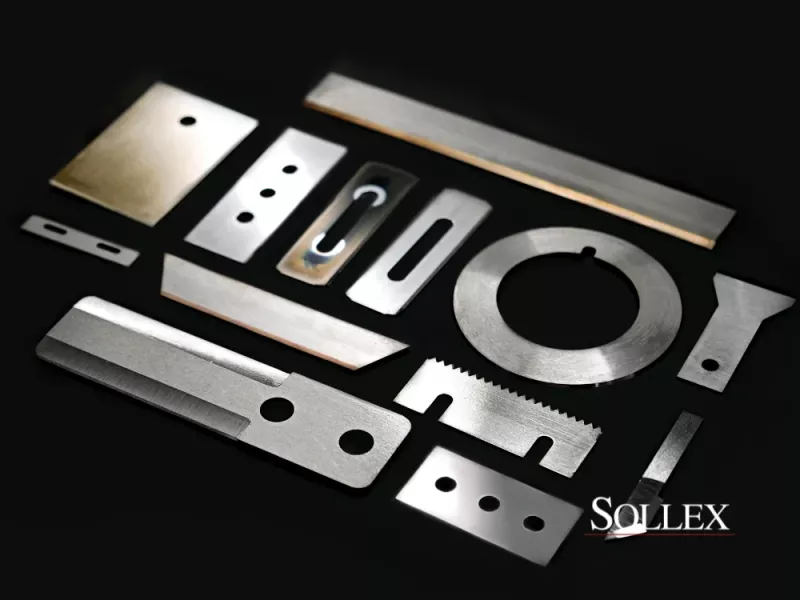
When it comes to the medical packaging industry, precision, reliability, and quality are non-negotiable. At SOLLEX, we understand these critical needs, which is why we specialize in providing top-tier machine knives and razor blades tailored for the medical packaging sector. Our products, including circular knives, shear knives, crush cut knives, perforator knives and 3-hole razor blades, slotted slitter blades, injector blades, are engineered to deliver the sharpness and durability required for clean, precise cuts every time. Whether you're cutting films, paper, or other flexible materials, SOLLEX offers the cutting solutions you need to maintain the integrity and sterility of your packaging.
Our blades are designed for durability, sharpness, and precision, ensuring clean cuts and optimal performance in your manufacturing processes. Contact us today to place your order and experience the SOLLEX difference.
Sollex is a Swedish supplier of industrial razor blades and machine knives for medical and pharmaceutical industries. We have cutting products with cutting-edge technology and performance that improve manufacturing and converting processes and solve problems. With the right knives and blades you can get simplified maintenance, time savings and an improved end product.
You are welcome to contact us with your questions:
Company name: Sollex AB
Customer service and orders: order@sollex.se
Telephone: +4635–15 75 00
Address: Box 5161, 200 71, Malmö, Sweden

